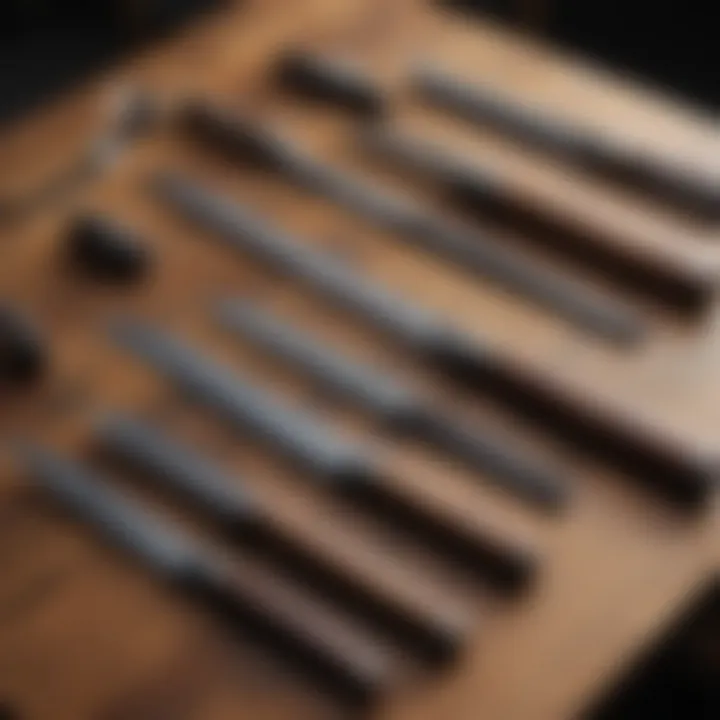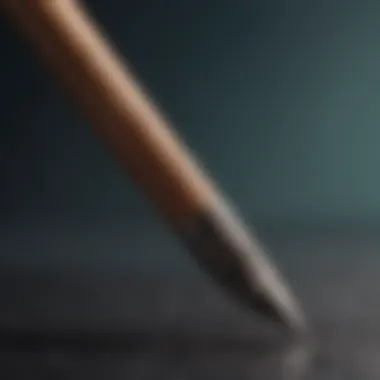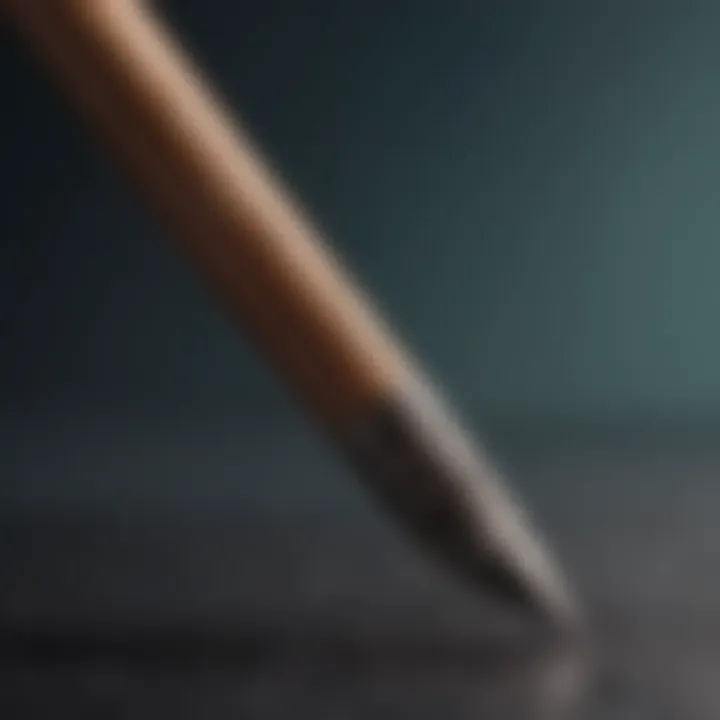Identifying the Best Knife Sharpening Tools


Intro
This article is designed to serve as a comprehensive guide, detailing the various knife sharpening tools available. It will explore critical aspects such as manual versus electric sharpeners, the merits of diamond over ceramic options, and the value of whetstones and honing rods. Throughout the exploration, the article aims to provide clear criteria for selecting the best sharpening tool tailored to individual needs and the specific types of knives in one’s collection.
Understanding these tools is not merely about effectiveness; it also encompasses usability and longevity. Each sharpening method has its place, advantages, and drawbacks. By the end, readers will be equipped with the knowledge necessary to make informed choices, ensuring that their knives maintain peak performance.
As you navigate through the sections, anticipate detailed comparisons and insights that facilitate better sharpening decisions.
Understanding Knife Sharpening
Knife sharpening is a fundamental aspect of maintaining kitchen cutlery and other blades. The ability to recognize the importance of sharp knives transcends mere convenience; it is tied directly to efficiency, safety, and overall performance in culinary tasks. Furthermore, this knowledge informs the selection of the most suitable sharpening tools, allowing users to make educated decisions that suit their particular needs. Failing to sharpen knives not only diminishes their functionality but also undermines the user's confidence in employing them.
Importance of Sharp Knives
Sharp knives are crucial in any cooking environment. The most immediate benefit is precision. A sharp blade allows for clean cuts, reducing food damage and enhancing presentation. This aspect can be particularly relevant for chefs who aim for visually appealing dishes. Besides the aesthetic advantage, sharp knives also contribute to safety. Dull knives require more force to cut, increasing the likelihood of slipping and causing injuries. Therefore, maintaining sharpness is not only about enhancing performance but also about ensuring the well-being of users.
Moreover, the longevity of knives can be significantly impacted by regular sharpening. By using the appropriate tools for maintenance, one can prolong the life of knives, which is often an investment in quality materials. In this context, investing time and effort in understanding sharpening techniques is not simply an optional task—it's essential.
How Sharpening Affects Performance
The performance of a knife is intricately linked to its sharpness. A well-sharpened knife can improve productivity in the kitchen. When knives glide through ingredients rather than tearing them, it reduces prep time compared to their dull counterparts. Each cut becomes smoother, resulting in a more enjoyable cooking experience.
Furthermore, sharpening maintains the geometry of the blade. Each knife is designed with a specific angle for the edge, and consistent sharpening preserves this angle, ensuring optimal cutting performance. The nature of the sharpening tools used, such as whetstones or honing rods, can also influence the final edge's sharpness.
Additionally, the effectiveness of sharpening plays a role in a knife's versatility. A sharp blade can transition easily between tasks, from slicing herbs to filleting fish, without the need for excessive force. This aspect highlights the advantage of investing in proper sharpening tools. One must also consider the long-term impact on preparation speed and the energy exerted.
Maintaining a sharp knife is integral to ensuring both efficiency and safety in the kitchen—neglecting this task can lead to unnecessary frustrations and potential accidents.
Types of Knife Sharpening Tools
In the realm of kitchen and culinary precision, the right sharpening tool is fundamental. It can significantly affect the lifespan of your knives and enhance their performance. Understanding different types of knife sharpening tools is essential for achieving and maintaining a sharp edge. Each tool has its unique characteristics, advantages, and considerations.
Manual Sharpeners
Manual sharpeners provide a hands-on approach to knife maintenance. They often come in various forms, such as handheld sharpeners or whetstones. One major benefit is the control they afford the user. You can regulate the angle and pressure applied to the blade. This method allows for a more customized sharpening experience. People who enjoy the ritual of sharpening often prefer these tools, as they can deliver superior edge refinement.
Electric Sharpeners
Electric sharpeners have gained popularity for their speed and efficiency. These tools significantly reduce the time and effort involved in sharpening. Most models have preset angles, which can be advantageous for novice users. However, reliance on electricity means they may not be suitable for all environments. There's an ongoing debate about the potential for edge damage with improper use. It's important to follow manufacturer instructions carefully to minimize this risk.
Whetstones
Whetstones are favored by many professional chefs and enthusiasts alike. They offer versatility and allow for precise adjustments in the sharpening process. Depending on the grits, a whetstone can achieve different levels of sharpness. The user must master the technique to maintain the angle consistently. While using whetstones usually takes time, the results can be surprisingly rewarding. Many people find satisfaction in the craftsmanship involved.
Honing Rods
Honing rods are often misunderstood. They are not true sharpeners but rather tools for maintaining an already sharpened edge. Regular use helps align the knife's edge and can extend the time between sharpening. The principle of using a honing rod is straightforward. You slide the blade along the rod at a consistent angle. While they cannot replace a sharpener, they are invaluable for routine blade maintenance.
Diamond Sharpeners


Diamond sharpeners use a diamond-coated surface to quickly grind away metal from the blade. Known for their durability, they can be more effective than traditional sharpeners in some instances. This can be especially beneficial for harder steels. Users appreciate their efficiency and the speed at which they can restore a blade to sharpness. However, the coarse nature of the diamonds necessitates caution. Overzealous sharpening can lead to unwanted wear on the blade.
Ceramic Sharpeners
Ceramic sharpeners offer another facet to knife maintenance. They tend to produce a finer edge compared to diamond options. The key advantage lies in their ability to refine an edge without removing excessive material. This makes them suitable for periodic upkeep rather than extensive sharpening. Ceramic sharpeners are often compact and easy to use, making them a favorite for many home cooks.
Each type of sharpening tool offers unique benefits. The choice often depends on personal preferences, specific knife types, and traditional approaches. Understanding these options allows users to select the best tool for their needs.
Criteria for Selecting Sharpening Tools
When it comes to knife sharpening, selecting the right tools is crucial. The diverse array of options available can make the process overwhelming. This section illuminates the key criteria to consider when choosing your sharpening tools.
Type of Knife
The first aspect to weigh is the type of knife you own. Different knives require varied sharpening methods. For instance, a chef's knife needs a different approach than a paring knife.
- Material: Stainless steel, carbon steel, and ceramic knives each have unique properties that affect the sharpening technique.
- Design: Some blades have a straight edge, while others are serrated. The latter often requires specialized tools for proper maintenance.
Make sure to match the sharpener to the knife type. Using the wrong tool can lead to ineffective sharpening, or worse, damage the blade.
Frequency of Use
Next, consider how often you use your knives. If you use them daily, investing in high-quality tools can prove to be a wise choice. Frequent use dulls knives faster, necessitating consistent sharpening.
- Light Use: For occasional cooks, a simple honing rod may suffice.
- Heavy Use: If you prepare food regularly, a whetstone or electric sharpener could be more effective. This allows for maintaining the blade's edge more thoroughly.
Infrequent users may not need elaborate setups, but those cooking often should prioritize tools that provide efficiency and effectiveness.
Skill Level
Your personal skill level also plays an essential role in your choice. If you are inexperienced in knife sharpening, the tools you select should accommodate your proficiency.
- Beginner: Manual sharpeners or electric options that simplify the process are ideal. They require minimal technique, ensuring that you achieve satisfactory results without extensive knowledge.
- Advanced: More seasoned cooks or chefs may prefer whetstones or specialized diamond sharpeners. These tools require skill and provide superior sharpness when used correctly.
Assess your comfort level with sharpening tools. This will lead to better outcomes and a more enjoyable experience.
Budget Constraints
Finally, budget constraints cannot be ignored. Knife sharpening tools vary widely in price, and it’s important to find a balance between cost and quality.
- Economical Options: There are budget-friendly manual sharpeners that serve basic needs. These can be a good start for occasional users.
- Investment: For serious cooks, higher-end tools like professional-grade whetstones or electric sharpeners may be beneficial in the long run. The initial cost is offset by the superior results and longevity of the tools.
In summary, assessing the above criteria enhances your ability to select the most suitable sharpening tool. By focusing on knife type, frequency of use, skill level, and budget, you can ensure that your knives remain in optimal condition.
Manual Sharpening Techniques
Manual sharpening techniques are essential for anyone who values the longevity and performance of their knives. Understanding these methods not only enhances the sharpness of the blade but also maintains its integrity over time. The benefits of manual sharpening are vast—it allows for more control, customization, and a deeper connection to the craft of knife maintenance. Unlike electric sharpeners, which can be convenient, manual techniques require patience and skill. However, learning them can lead to significant improvements in how effectively a knife performs.
Using a Whetstone


Using a whetstone is a traditional and highly effective way to sharpen knives. A whetstone consists of a stone with two sides, typically coarse and fine. Each side serves a distinct purpose in the sharpening process. The coarse side removes dull material from the blade, while the fine side polishes it. To achieve the best results, you first need to soak the whetstone in water for a short period. This step helps to create a slurry that aids in the sharpening process.
The angle at which you hold the knife is critical. Most knives require an angle between 15 to 20 degrees. When dragging the blade across the stone, apply consistent pressure and ensure even strokes. Repeating this process on both sides of the blade will yield a sharp and refined edge. Whetstones require practice, but their ability to sharpen a variety of blade types makes them a favorite among passionate cooks and knife enthusiasts.
Employing a Honing Rod
A honing rod is another valuable tool for maintaining knife sharpness, though it is not a sharpening tool in the same sense as a whetstone. Instead, it aligns the edge of the knife, ensuring it remains straight and true. Over time and with use, the delicate edge of a knife can bend or become misaligned. Regularly honing the knife can prevent extensive dulling.
To use a honing rod effectively, hold the rod vertically and place the knife against it. Angle the knife similarly to how you would with a whetstone. Glide the blade down the rod while applying gentle pressure, alternating sides until you feel the edge is aligned. This technique is quick and can be done frequently, making it an excellent practice to incorporate into your kitchen routine.
Diamond vs. Ceramic Sharpeners
When considering manual sharpening tools, the choice between diamond and ceramic sharpeners is significant. Diamond sharpeners are renowned for their aggressive cutting ability and durability. They consist of a metal surface coated with diamond particles. This feature allows them to sharpen even the hardest knife steels with relative ease. Typically, diamond sharpeners come in various grits, making them versatile for different blade types.
On the other hand, ceramic sharpeners are gentler and best suited for light touch-ups. They polish the edge rather than reshape it. Ceramic sharpeners glide over the blade without removing significant material, making them ideal for maintaining an already sharp knife.
Both options have their merits. The choice often depends on the specific needs of the user and the condition of the knives. For someone who frequently uses their knives, investing in both types can offer comprehensive coverage in maintaining knife sharpness.
Note that understanding how to select and use these manual sharpening tools is crucial for optimal knife performance. Adequate care of the blade can enhance not only its longevity but also the quality of its cutting ability.
Electric Sharpeners: Pros and Cons
Electric sharpeners have gained popularity among both novice and seasoned cooks. Their appeal stems from a combination of efficiency, consistency, and ease of use. However, understanding the pros and cons of these tools is essential for making an informed decision. This section focuses on the benefits and considerations associated with electric sharpeners.
Efficiency and Speed
One of the primary advantages of electric sharpeners is their efficiency. Unlike manual methods, which may require time and practice to master, electric sharpeners deliver quick results. With a simple push of a button, these devices can sharpen a dull blade in mere seconds. This can be especially beneficial for individuals who use their knives frequently and need a reliable tool to keep them sharp.
Additionally, electric sharpeners usually come equipped with guides that ensure the correct angle. This feature benefits less experienced users and reduces the chances of making errors. Many models can also accommodate various types of knives, making them versatile options for different kitchen tasks.
Potential for Blade Damage
Despite their convenience, electric sharpeners can pose risks. The most significant concern is the potential for blade damage. Unlike manual sharpening methods that allow for more control, electric sharpeners apply consistent pressure that may cause overheating. This heat can damage the knife's edge, reducing its effectiveness in the long run.
Moreover, many electric sharpeners have fixed angles that may not suit every knife type. Using a fixed angle on a specialized knife can lead to an improper edge, which may lead to suboptimal performance. Therefore, it is imperative to use these devices cautiously.
Best Practices for Use
To maximize the benefits of electric sharpeners and minimize potential risks, following a few best practices is advisable:
- Choose the Right Model: Select an electric sharpener designed for the specific types of knives in your collection. Some sharpeners are better for certain materials and blade styles.
- Avoid Excessive Use: Do not rely solely on an electric sharpener. Rotating between different sharpening methods can help preserve the blade's integrity.
- Maintain and Clean: Regularly clean the sharpener to ensure it remains effective. Read the manufacturer's guidelines for proper maintenance.
- Test Results: After sharpening, always test the knife on a piece of paper or food to assess sharpness before use.
"Electric sharpeners can be quick and efficient, but caution is needed to avoid damaging the blade."
By weighing the pros and cons, individuals can better gauge if an electric sharpener aligns with their knife maintenance needs.
Evaluating Quality and Durability
When selecting a knife sharpening tool, the quality and durability of the product play a paramount role. A high-quality sharpener not only enhances the efficiency of knife maintenance but also extends the lifespan of your knives. Therefore, understanding the factors that influence the quality and durability of sharpening tools is key.


Quality impacts the performance of the sharpening process. Poor tools often lead to subpar results, like uneven edges or even damage to the blade. As these tools are significant investments, knowing what to look for ensures that you make a wise choice.
Material Considerations
Materials used in sharpening tools greatly affect their performance and longevity. Here are some common materials you may encounter:
- Steel: Often used in electric sharpeners, steel can be durable but may wear down more rapidly than other materials.
- Diamond: Diamond sharpeners offer a high level of hardness and sharpening capabilities. They maintain their integrity over time and provide excellent results.
- Ceramic: Ceramic tools are gentler on blades and offer a fine sharpening surface. They may not be as durable as diamond, but they present a loyal option for everyday use.
Consumers should consider how often they will sharpen their knives. Frequent use can cause wear, thus investing in high-quality materials can save you costs in the long term.
Brand Reputation
Brand reputation can serve as a strong indicator of quality. Established brands often have a history of producing reliable, effective products. When considering a brand, look for:
- Longevity: Brands in the market for many years likely understand the nuances of knife care.
- Recognition: Reputation within the cooking and culinary community is vital. Well-known brands are often a safe choice as they undergo rigorous testing before reaching consumers.
- Innovation: Brands that invest in research and development tend to produce tools that are at the forefront of technology and usability.
Doing thorough research on a brand can provide insights into its reliability, which positively impacts your investment.
User Reviews and Recommendations
User reviews are a valuable resource when evaluating the quality of sharpening tools. They offer real-world insight into the product’s performance and reliability. Here are elements to focus on when exploring user reviews:
- Overall Satisfaction: General feedback on how well the sharpener performs can guide your decision.
- Specific Usability: Look for reviews discussing ease of use, cleaning ease, and how the sharpener holds up over time.
- Recommendations: Recommendations from professionals can give you confidence, especially if they are from chefs or knife enthusiasts who understand the importance of quality in sharpening tools.
Maintenance of Sharpening Tools
Maintaining sharpening tools is crucial for both performance and longevity. Proper care can significantly enhance the effectiveness of sharpening. Knives require periodic sharpening, and if the tools used in this process are not well maintained, it can lead to compromised performance and even damage to your blades.
One major aspect of maintenance is regular cleaning. Sharpening tools can accumulate residue from the grinding process. This residue can hinder their function, resulting in uneven sharpening and possible damage to the knife edge if not addressed. Moreover, a clean tool ensures that no impurities are transferred to the blade, preserving its integrity.
Cleaning and Storage
Cleaning sharpeners should be a routine task after each use. For example, whetstones require a simple rinse with water to dislodge particles, while electric sharpeners may need the removal of dust and debris. Additionally, storaging the sharpening tools correctly is another significant factor in their longevity.
Protecting them from humidity and extreme temperatures will prevent degradation. Placing tools in a dry and cool area can extend their life. Using pouches or dedicated storage containers can also prevent scratches and maintain the surface quality.
Tip: Regularly check storage areas for mold or rust that could affect performance.
Long-term Care Tips
Long-term care of sharpening tools is necessary to assure they remain effective over time. One crucial suggestion is to apply maintenance oils to maintain surfaces, especially in metal tools. This prevents rust and keeps the surfaces smooth for better sharpening results.
Inspect your tools periodically for wear and tear. If you notice any damages, consider replacing parts or, if possible, the whole unit. Always follow the manufacturer's guidelines for care strategies to ensure the tools continue to perform optimally.
Culmination
In the realm of knife maintenance, recognizing the role of sharpening tools is vital. This article emphasizes the necessity of selecting appropriate sharpening tools, as the right choice can greatly enhance the longevity and performance of knives. A keen blade is not merely a matter of appearance; it is essential for efficiency and safety in the kitchen or any culinary setting.
The discussion in earlier sections covers various tools available. We explored manual versus electric options, emphasizing that each has its distinct advantages and disadvantages. Manual sharpeners, such as whetstones and honing rods, offer control and precision, while electric models deliver speed and consistency. Understanding these aspects aids in making informed decisions tailored to individual needs.
Moreover, we examined critical factors like the type of knife, frequency of use, skill level, and budget constraints. These elements collectively shape the user's experience with sharpening tools and influence the maintenance routine for kitchen equipment.
"Investing in quality sharpening tools is as crucial as selecting high-end knives. The efficiency of your blade directly relates to its maintenance."
Summary of Key Points
- Importance of Sharp Knives: Sharp knives lead to better precision and safety in food preparation.
- Types of Sharpening Tools: Various options exist, such as manual and electric sharpeners, each with unique features.
- Criteria for Selection: Factors like knife type and user skill should guide the choice of sharpening tools.
- Maintenance Practices: Regular cleaning and care extend the life of sharpening tools.
- Long-Term Investment: Selecting quality tools enhances the user experience and knife longevity.







